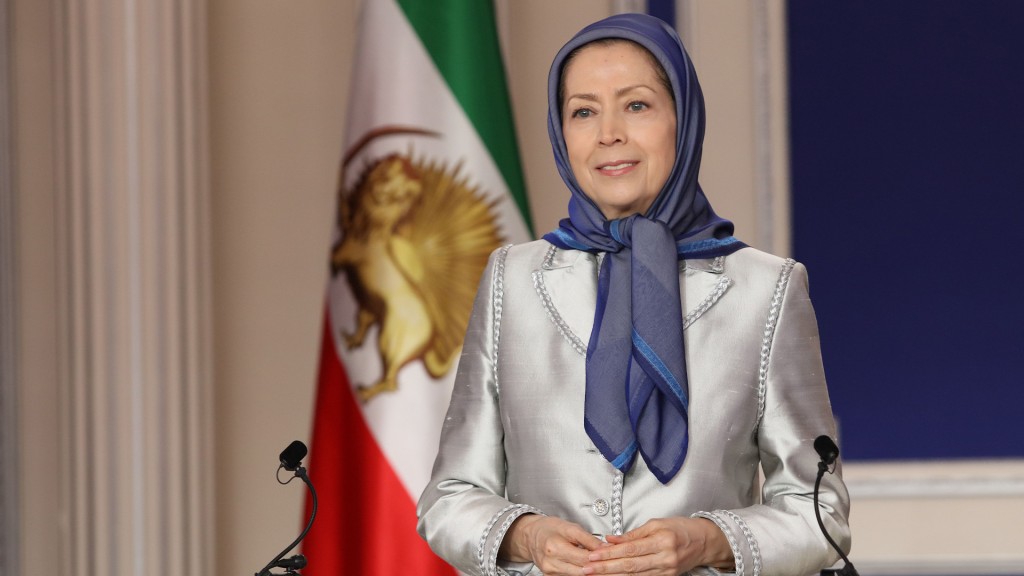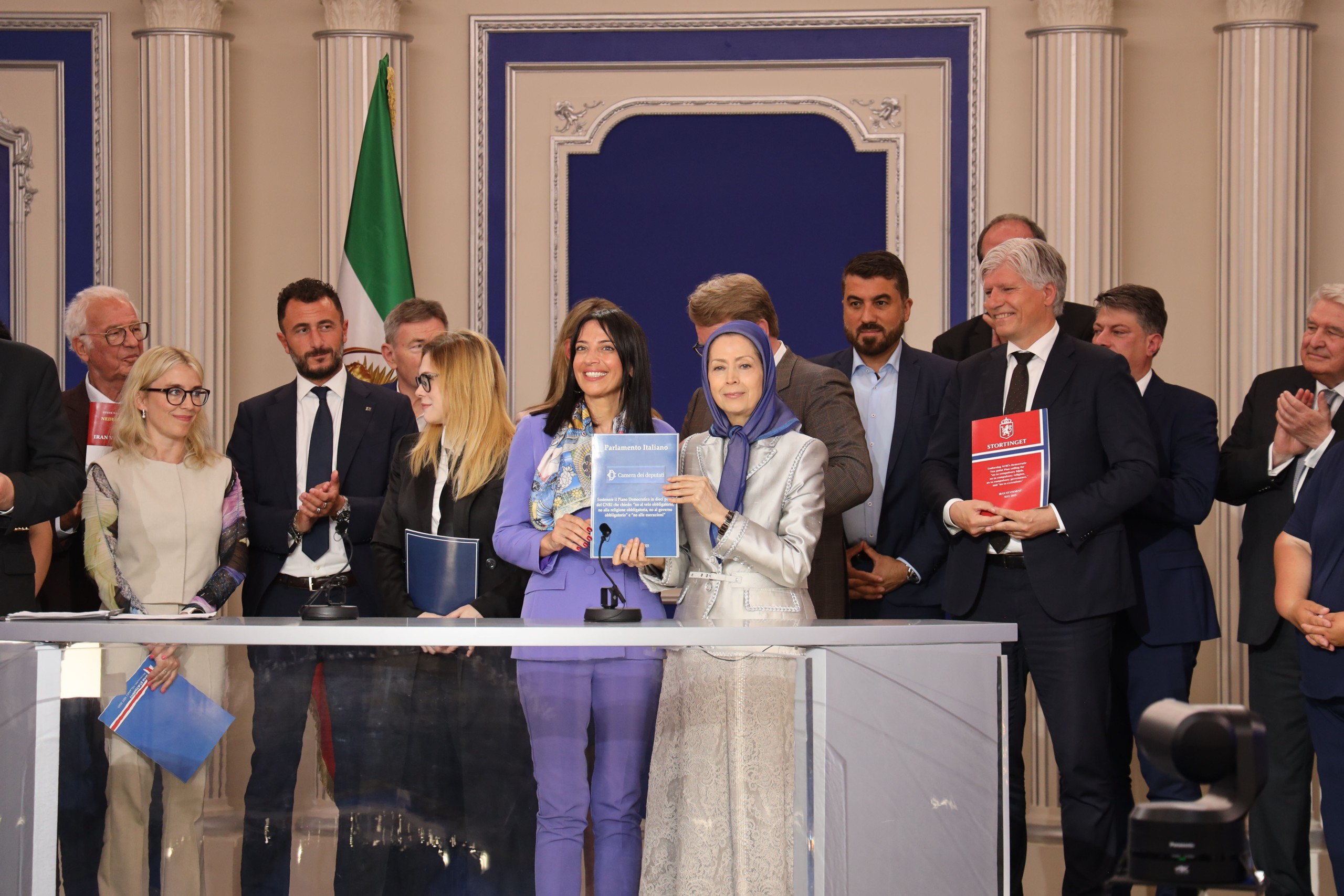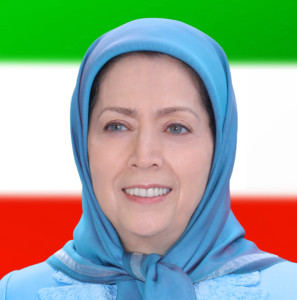Second Free Iran 2025 Conference: Regime Change is the Only Path

Maryam Rajavi: The Only Solution to the Regime’s Nuclear Weapons Program is Regime Change by the Iranian People and Resistance
Honorable Lawmakers,
Dear Guests and Distinguished Personalities,
It is a true pleasure to welcome you today to the Home of the Iranian Resistance. We are delighted to have you with us—welcome!
We also extend our warmest greetings to our brothers and sisters in Ashraf 3 who are joining us virtually for this gathering.
Dear Friends,
The Iranian people’s Resistance, rooted in a legacy of courage, sacrifice, and unyielding struggle by an organized movement and a bold, rebellious generation, is fighting for a sweeping transformation: to bring down religious dictatorship and establish a free, democratic republic in its place.
The Real Solution to the Iran Crisis
The tumultuous events of the past year have underscored, more than ever, the vital importance of a democratic alternative that holds the key to resolving the crisis in Iran.
Over the past year, the clerical regime suffered a decisive blow: its 40-year stronghold in Syria collapsed, despite deploying over 100,000 armed forces. Its strategic proxy—despite a massive arsenal of 150,000 missiles—was irreparably crippled. Meanwhile, the regime’s terrorist and military arms in Iraq have been silenced and brought to a standstill.
More importantly, the regime is now facing a tsunami of internal crisis, political turmoil, widespread public discontent, and deepening economic and social challenges. Over the past year, its sham elections were boycotted by more than 90% of the population.
But what has brought the regime to such a weakened and fragile state?
The Catastrophic Economic and Social Situation in Iran
To understand what has driven the regime to this fragile state, let us briefly examine the situation of the ruling regime and the economic, social, and political conditions in Iran.
One needs only to listen to a few speeches by Khamenei’s handpicked president to grasp the severity of Iran’s economic crisis. He constantly laments the country’s systemic imbalances—budget deficits, energy shortages, water and electricity crises, natural gas disruptions, medicine and bread scarcity, as well as a shortage of educational resources, healthcare services, public transportation, and much more.
He acknowledges these glaring shortages in an attempt to defuse public anger and suppress the growing wave of dissent. But what he conceals is far more telling: how the regime squanders the nation’s wealth on nuclear projects, missile programs, and warmongering campaigns across the region. Decades of systematic looting have pushed Iran’s economy into a state of deep crisis—one that is now spiraling out of control.
Today, major state-owned financial and economic institutions, including banks, insurance companies, social welfare organizations, and pension funds, are either bankrupt or teetering on the edge of collapse.
Over the past four years, the ruling regime has earned substantial revenue from the sale of oil and petrochemical products. Yet, the machinery of repression and war devours it all, leaving nothing for the impoverished people of Iran.
Each year, the budget deficit grows larger than the last, and the regime’s obedient government is buckling under the weight.
Runaway inflation has become a tool for looting the pockets of ordinary citizens. Purchasing power has plummeted, the Iranian rial has become one of the world’s most worthless currencies, and investment across many sectors has all but dried up. Meanwhile, more and more of the nation’s financial capital is fleeing the country every year.
The rapid collapse of Iran’s economy is most visibly reflected in the severe shortages of electricity and natural gas.
Iran holds the third-largest oil reserves and the second-largest natural gas reserves in the world. And yet, a significant portion of the gasoline needed for domestic use is imported. The regime has become so incapable of meeting the country’s basic energy needs that cities across Iran experience daily blackouts lasting several hours.
This has thrown daily life into disarray, disrupting businesses, halting school and university operations, forcing many production facilities to shut down, and triggering a new wave of unemployment across the country.
The regime has wasted over $2 trillion on nuclear projects—yet less than 2% of Iran’s electricity is generated by nuclear power plants.
Had the regime invested even just 10% of that amount into building solar or gas power plants, the daily lives of millions of Iranians would not be plunged into such widespread hardship and chaos.
One of the most alarming tsunamis sweeping through Iranian society today is the mass deprivation of tens of millions of people from their most basic needs, leaving many homeless.
This regime has destroyed job security, stripped vast segments of the population of access to healthcare and insurance, and made education, internet, housing, and affordable transportation increasingly out of reach. Through the systematic devaluation of labor and exploitation of workers, the regime has brought society to the brink of social unrest and upheaval.
Over 95% of Iran’s 20 million-strong labor force now work in the informal sector—meaning their jobs are unstable, temporary, and offer no future.
A quarter of Iran’s population has been pushed into impoverished, underserved outskirts, driven there by homelessness and grinding poverty. And as always, the first and most vulnerable victims of this crisis are women and children.
Severe water shortages—and, in certain regions, conditions approaching water famine—have placed a significant portion of the population under considerable duress. In Iran, water is a profoundly political issue. The systematic exploitation of water resources by the Revolutionary Guard Corps (IRGC), coupled with Khamenei’s anti-patriotic policies, has caused substantial and lasting harm to the country’s strategic water reserves.
In short, the defining characteristic of Iranian society today can be summed up as a widespread hostility toward the regime. The majority of people, in their everyday conversations, position themselves in direct opposition to the ruling establishment, often referring to the dichotomy as “them” versus “us.” A vast and unbridgeable divide has formed between the two sides.
For decades, the regime has maintained a police-state grip over factories and universities through the presence of Basij paramilitary forces. Now, this control is being extended even further. A new official agreement has recently been signed between the regime’s repressive police force and its Minister of Education, placing schools, students, and teachers under direct security oversight.
Every year, between one and one and a half million people are arrested.
During Masoud Pezeshkian’s brief ten-month tenure, the regime carried out more than 1,275 executions, 170 of them in just a single month, between April 21 and May 21.
Yet despite this brutal wave of arrests and executions, Iran’s cities continue to erupt daily with protests and strikes—from oil, gas, and petrochemical workers, to farmers, nurses, teachers, miners, bakers, truck drivers, and retirees.
Approximately 10 days ago, courageous truck drivers launched a nationwide strike across 152 cities in 31 provinces. They cry out against a system built on injustice.
Today, they are the voice of millions upon millions of hardworking people who have been plundered by this regime. One must ask: why is it that these drivers, who demand nothing more than their most basic rights, receive no response, and instead are met with arrest and repression?
To the noble people of Iran, I say, in unison with them—stand with them, and support this nationwide strike! The arrested drivers must be released.
Hardworking bakers, struggling just to earn their daily bread and feed their communities, have had enough crushed by the rising cost of flour, constant power outages, and the ruin of their labor. They have made it clear: they will not remain silent.
In the prisons, too, the voices of political prisoners rise each week in the powerful campaign of “No to Executions Tuesdays.” Their defiance and courage continue to inspire the nation every week. This campaign has now reached its 70th consecutive week, echoing from inside 45 prisons across the country. Hail to them all!
As Massoud Rajavi, the Leader of the Iranian Resistance, once said, the Shah made the ridiculous claim of leading a “White Revolution,” while the mullahs, with hypocrisy and deception, spoke of something they called an “Islamic Revolution.” But we, through a sea of fire and blood, have always stood for a new democratic revolution, one that includes all the oppressed classes and segments of society. No matter what the price, and no matter how long it takes.
Yes, the day is not far off when the simmering rage of the Iranian people will erupt in a firestorm of organized uprising—led by the Resistance Units—and reduce this tyrannical regime to ashes.
The National Council of Resistance: A Ready and Viable Alternative
Dear friends,
The most decisive factor shaping the current crisis for the regime is the existence of a strong, prepared alternative—the National Council of Resistance of Iran (NCRI). This coalition stands as the true representative of the Iranian people’s enduring aspirations for freedom and democracy.
Equipped with the necessary capabilities, the NCRI is uniquely positioned to lead the overthrow of the religious dictatorship. In these revolutionary times, it spearheads a courageous and dedicated movement, organizing a broad and sustained uprising aimed at ending tyranny.
This vigorous struggle, relying on Iran’s defiant youth and led at its core by the PMOI Freedom Fighters and Resistance Units, is steadily moving toward victory.
Although the activities and operations of these Resistance Units are largely censored in Western media, they remain the vanguard of this struggle, and this is what terrifies the mullahs.
The clerical regime is profoundly fearful of the rapidly growing wave of young Iranians who are turning to the PMOI and this resistance as their path to freedom.
The regime’s deep-seated fear is laid bare by the biweekly show trials it conducts in Tehran—targeting 104 members and leaders of the Resistance and the PMOI, all tried in absentia.
The PMOI’s extensive social network, embedded across all sectors of Iranian society, has enabled access to the regime’s most sensitive and classified information. Thanks to this very network, the National Council of Resistance of Iran was able to reveal, just three weeks ago in Washington, D.C., one of the regime’s secret nuclear sites located in Semnan.
The Clerical Regime at a Crossroads: Self-Destruction or Inevitable Collapse
For 34 years, the Iranian Resistance has thwarted a terrorist dictatorship’s pursuit of nuclear weapons, denying the regime the element of surprise through a consistent stream of revelations exposing its secret sites and illicit programs.
It was the Iranian Resistance that, in 2002, exposed the covert nuclear facilities in Natanz and Arak. This disclosure compelled Khamenei to halt uranium enrichment—at least temporarily—and submit to the sealing of those nuclear sites.
The international community must therefore remain vigilant and adopt a firm policy to prevent the clerical regime from once again deceiving the world.
News agencies reported today that the International Atomic Energy Agency in its latest report has stated that the clerical regime’s stockpile of enriched uranium has reached 10 tons. More importantly, the IAEA has revealed that the regime has moved its nuclear material and contaminated nuclear equipment to an unknown location.
Yes, the regime’s nuclear project has brought it to a fateful crossroads: suicide or collapse. One path would require Khamenei to abandon this deeply anti-patriotic pursuit and halt uranium enrichment—a step he has steadfastly avoided. Why? Because the regime has tied its very survival to this project. Any retreat would fracture Khamenei’s authority and accelerate the regime’s plunge toward inevitable overthrow.
The other path is the regime’s continued pursuit of nuclear weapons.
Its insistence on expanding missile programs, building a bomb, and fueling state-sponsored terrorism—all point in this direction. The latest example: a terrorist operation recently uncovered in the United Kingdom.
Yes, a regime that supports missile attacks on international shipping lanes in the Red Sea and relentlessly escalates mass executions and torture is indeed following this course.
As I have emphasized, this strategy has reached a complete dead end. The inevitable outcome of Khamenei’s path is uprising and ultimately, the regime’s overthrow.
Standing with the Iranian People’s Resistance
At this point, I salute all of you, honorable lawmakers and your colleagues, who have led the way in issuing statements of support for the Iranian people’s Resistance from the majority of parliaments in Italy, Norway, Moldova, Iceland, Costa Rica, and the Dutch Senate, as well as from the majority of state parliaments in Brandenburg, and Saxony in Germany.
Dear friends,
From the perspective of international politics, the situation in Iran has reached a critical juncture where all illusory and doomed options have been unequivocally set aside.
The question of Iran’s future has but one legitimate solution—a solution entrusted to the Iranian people and the Iranian Resistance.
Similarly, the regime’s state-sponsored terrorism and relentless warmongering across the region can only be answered through one course: the overthrow of the regime by the people of Iran and the Iranian Resistance.
Ultimately, the regime’s nuclear weapons program has but a single possible fate—a decisive regime change, achieved by the courage and determination of the Iranian people and their Resistance movement.
Our call to Europe and the entire world is clear and imperative:
To designate the Revolutionary Guard Corps (IRGC) as a terrorist organization.
To officially recognize the Iranian people’s struggle to overthrow the clerical regime.
And to acknowledge the courageous struggle of the Resistance Units in their fight against the criminal IRGC.
Indeed, the freedom of Iran is the guarantee of peace in the region and security for the world.
And in the end, as Massoud Rajavi said, “Iran remains trapped in the grasp of clerical devils, wrestling with executions, poverty, corruption, and darkness. Yet, ultimately, our most beautiful homeland shall bloom into a garden of freedom and justice.”

- Tags: mullahs' regime, NCRI, people of Iran, Uprising

